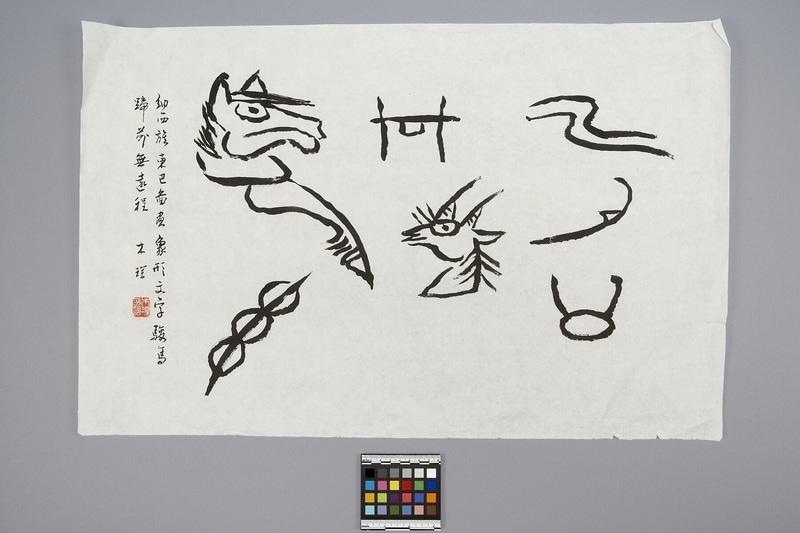Calligraphy Item Number: 2636/2 from the MOA: University of British Columbia

Description
Thin, white, handmade paper with seven Dongba pictographic script in black ink. Chinese characters appear down the left side with a red stamped seal. Images include the following from top down left to right: a profile of a horse head with a hoof and three circles intersected by a line; an elongated H-shape with a rectangle underneath the bar and a profile of a goat head; and a backwards double s-shape, a curve hook shape, and an oval that has two long upward curved protrusions. The paper is horizontally rectangular.
History Of Use
This calligraphic work shows seven Dongba pictographs, written with a stylus using black ink on handmade paper. In contrast to the ritual texts that were arranged in horizontal registers, this work reflects a modern approach to Dongba writing that evolved during the 1980s and onwards, a time of cultural revival for economic development and tourism. This is evident from the vertical lines of Chinese calligraphy on the left that offer explanatory notes regarding the “Dongba pictographs of the Naxi nationality.” The Naxi (or Nakhi) people of China’s Yunnan and Sichuan Provinces are known for their distinctive Dongba shamanism and mainly pictographic writing system. Dongba is one of two systems used by the Naxi people to write their language, which is part of the Tibeto-Burman family. It is named for the shamans who used it to facilitate ritual ceremonies in their religion, which is related to the Tibetan Bön tradition. The writing was in use by the seventh century and grew to encompass over two thousand characters. Since the Communist Revolution of 1949, thousands of Dongba texts have been destroyed in various ideological campaigns. Today there are about sixty Dongba shamans who can still read and write the script.
Item History
- Made in Yunnan, China
- Owned by Elizabeth L. Johnson before December 2, 2004
- Received from Elizabeth L. Johnson (Donor) on December 2, 2004
What
- Name
- Calligraphy
- Identification Number
- 2636/2
- Type of Item
- calligraphy
- Overall
- height 43.2 cm, width 67.7 cm, depth 0.1 cm
Who
- Culture
- Naxi Dongba
- Previous Owner
- Elizabeth L. Johnson
- Received from
- Elizabeth L. Johnson (Donor)
Where
- Holding Institution
- MOA: University of British Columbia
- Made in
- Yunnan, China
When
- Ownership Date
- before December 2, 2004
- Acquisition Date
- on December 2, 2004
Other
- Item Classes
- works on paper
- Condition
- good
- Accession Number
- 2636/0002